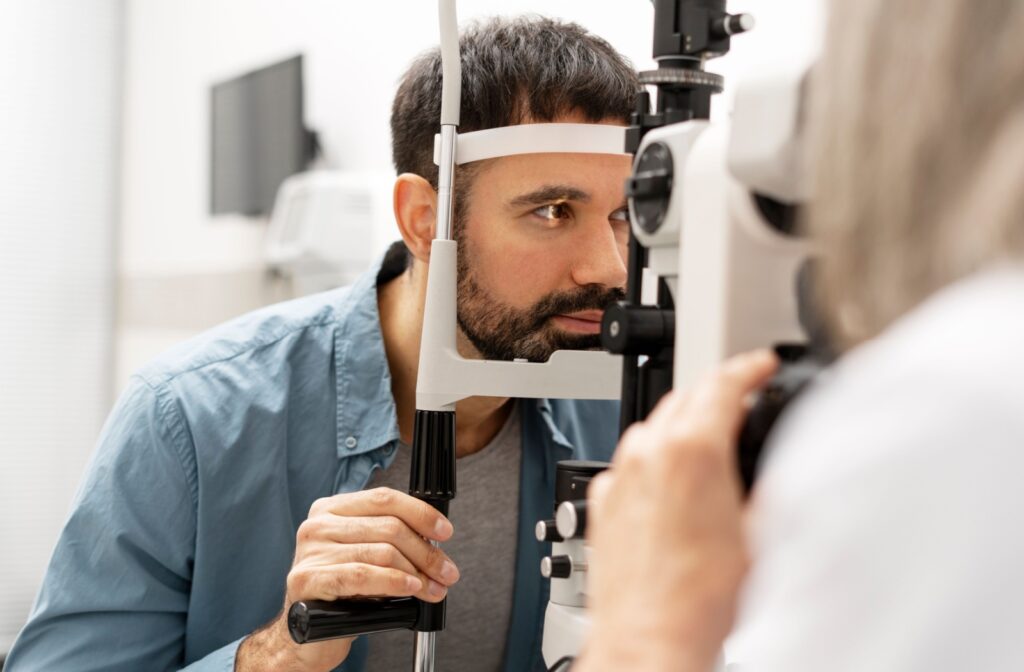Discovering a red spot on the white of your eye can be startling. Some people notice them after a sneeze, cough, or even while lifting something heavy—which can easily make you think that something has gone wrong. Known as a subconjunctival hemorrhage, this condition might look alarming but is typically harmless.
It occurs when a tiny blood vessel bursts under the clear surface of your eye, and it usually resolves on its own within 1–2 weeks. Your optometrist can always examine your eye and help put your mind at ease.
What Are Broken Blood Vessels in the Eye?
A broken blood vessel in the eye, or subconjunctival hemorrhage, is caused by a rupture of one of the delicate blood vessels beneath the conjunctiva, the clear membrane that covers the white part of your eye. When this happens, it results in a red patch or area that can vary in size, depending on how much blood has leaked out.
Though it may look severe, this condition is rarely painful, and your vision shouldn’t be affected. Most importantly, it doesn’t require treatment in most cases—just some time to heal.
Common Causes of Broken Blood Vessels
While sometimes a broken blood vessel can seemingly appear out of nowhere, they shouldn’t happen randomly and can often be traced back to some innocuous event. Here are some of the common causes of a broken blood vessel in the eye:
Sudden Pressure Changes
The tiny vessels in your eye can rupture from a sudden increase in pressure, which can occur due to common activities such as:
- Sneezing
- Coughing
- Vomiting
- Heavy lifting
These actions create a strain force within your body that can occasionally impact your ocular blood vessels.
Eye Rubbing & Trauma
Rubbing your eyes too vigorously can place undue stress on the blood vessels and cause them to break. Accidental trauma, such as an injury while playing sports or applying makeup, can also lead to a subconjunctival hemorrhage. For contact lens users, improper handling of lenses can irritate the eye and increase the likelihood of a rupture.
Medical Conditions & Medications
Certain underlying health issues and medications make blood vessels more prone to breaking:
- High blood pressure: Elevated blood pressure can strain the vascular system, including the delicate vessels in your eyes.
- Blood thinners or anticoagulants: Medications like aspirin or warfarin can increase the risk of subconjunctival hemorrhages by affecting clotting.
- Blood disorders: Conditions that impact the blood’s ability to clot can also make these vessels more susceptible to rupture.
Environmental & Lifestyle Factors
Sometimes, environmental or daily habits contribute to the development of broken blood vessels:
- Dry air or allergens: These can irritate your eyes and prompt frequent rubbing.
- Smoke or irritants: Exposure to certain environmental irritants can aggravate your eyes.
- Prolonged screen use: Spending extended periods of time staring at a screen without breaks may strain your eyes, making you more likely to rub them.

When to Seek Professional Eye Care
Most broken blood vessels in the eye resolve on their own in 1–2 weeks as the eye naturally heals. In the meantime, you can use artificial tears to deal with any discomfort. However, even though most without assistance, there are certain situations where you should consult an eye care professional:
- Frequent hemorrhages: If you experience this condition frequently, it might indicate an underlying issue, such as unmanaged hypertension or a blood disorder.
- Accompanying symptoms: Seek prompt care if the broken blood vessel is paired with eye pain, vision changes, or pressure around the eye.
- Trauma-induced: If your broken blood vessel follows a significant injury, especially to the head or eye, you should have it assessed.
An optometrist can provide a thorough evaluation to check if your eyes are healthy and offer tailored solutions for any underlying concerns.
Preventing Broken Blood Vessels & Care Tips
While it’s not always possible to prevent broken blood vessels, here are a few tips to reduce your risk:
- Avoid rubbing your eyes: Be gentle when touching your eyes or inserting contact lenses.
- Wear protective eyewear: Use safety goggles or glasses during activities that pose a risk of eye injuries.
- Manage underlying conditions: Work with your healthcare provider to manage high blood pressure or clotting disorders effectively.
- Take regular screen breaks: Follow the 20-20-20 rule—look 20 feet away every 20 minutes for 20 seconds—to reduce screen-related eye strain.
- Stay hydrated and rested: A well-balanced diet, proper hydration, and sufficient sleep can support the health of your eyes.
For specific prevention strategies or custom eye care advice, your optometrist is here to help every step of the way.
Your Eyes Are Our Top Priority
At Total Vision Richmond, we understand how alarming sudden eye conditions can be, which is why we’re committed to providing comprehensive, family-friendly care for all your eye health needs. Whether you need reassurance that your subconjunctival hemorrhage is healing well or ongoing monitoring for a recurring condition, our experienced team is here to keep your vision at its best.
Don’t wait—your eyes deserve expert care. Book an appointment today, and take the first step toward total vision health.


